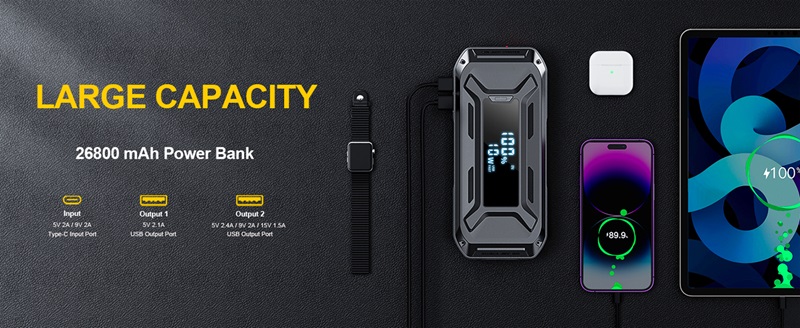In an era where mobility is paramount, jump starters have become essential tools for addressing unexpected car battery failures. However, many car owners are concerned about the potential damage these devices could cause to their vehicle's battery health. This thorough review seeks to explore the mechanics of jump starters, clarify common misconceptions, assess their impact on battery longevity, and offer practical advice for their safe and effective use.
Jump starters, also known as battery boosters or jump packs, are portable devices designed to provide a quick burst of power to a car's battery, enabling the engine to start. These devices typically consist of a rechargeable battery pack, cables, and clamps that connect to the car battery's terminals. Modern jump starters come with various features, such as built-in air compressors, USB ports, and LED lights, enhancing their utility.

When a car battery is too weak to start the engine, a jump starter supplies the necessary voltage and current to get the engine running. The jump starter's internal battery delivers a high current through the cables and clamps connected to the car's battery. This temporary boost of power turns the starter motor, which cranks the engine. Once the engine starts, the alternator takes over, recharging the car's battery.
While jump starters are generally safe and effective, there are some potential risks associated with their use. Understanding these risks can help car owners use jump starters safely and avoid damaging their car batteries.
Overvoltage and Overcurrent: Using a jump starter with an incorrect voltage rating or one that supplies too much current can damage the car battery and electrical system. Most car batteries are 12-volt, but using a higher voltage jump starter can cause severe damage.
Reverse Polarity: Connecting the jump starter clamps to the wrong battery terminals (positive to negative and vice versa) can lead to reverse polarity. This mistake can damage the car battery, the jump starter, and the vehicle's electronic systems.
Poor Quality Jump Starters: Low-quality or poorly designed jump starters may not have adequate safety features, such as overcurrent protection, short-circuit protection, and reverse polarity protection. Using such devices increases the risk of damaging the car battery.
Repeated Jump Starting: Frequently relying on a jump starter instead of addressing the underlying issues with the car battery or electrical system can lead to long-term damage. Continuous use of a jump starter may indicate a failing battery or alternator that needs to be replaced.
To mitigate the risks associated with using a jump starter, car owners should follow these best practices:
Choose the Right Jump Starter: Ensure the jump starter matches the voltage and power requirements of your car battery. Check the manufacturer's specifications and opt for a device with built-in safety features.
Proper Connection: Always connect the positive clamp to the positive terminal and the negative clamp to the negative terminal of the car battery. Double-check the connections before turning on the jump starter.
Follow the Instructions: Read and follow the jump starter's user manual carefully. Manufacturers provide specific instructions to ensure safe and effective use of their products.
Avoid Repeated Use: If your car battery frequently requires jump starting, have it inspected by a professional. The underlying issue might be a failing battery, a faulty alternator, or another electrical problem that needs to be addressed.
Regular Maintenance: Regularly check and maintain your car battery to prevent it from dying unexpectedly. Ensure the battery terminals are clean, secure, and free from corrosion. Regular maintenance can extend the life of your car battery and reduce the need for jump starting.

While jump starters are an invaluable tool for reviving a dead car battery, they must be used correctly to avoid potential damage. Overvoltage, reverse polarity, and poor-quality devices are common risks associated with their use. By selecting the right jump starter, ensuring proper connections, and following manufacturer instructions, car owners can safely use these devices without harming their batteries. Regular maintenance and addressing underlying electrical issues can also reduce reliance on jump starters, ensuring the longevity and reliability of your car's battery.
By continuing to use the site you agree to our privacy policy Terms and Conditions.